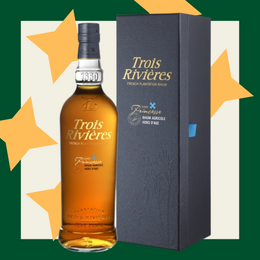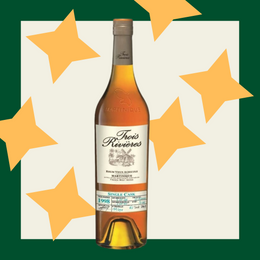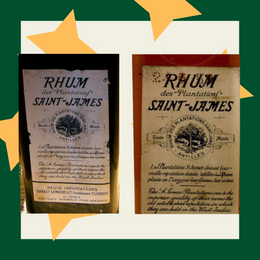
At the start of 2017 (which we hope will live up to your expectations), we invite you to relive a part of the history of agricultural rum with the J. Bally 1998 rum, released at the end of 2016 to mark LMDW's 60th anniversary. Even though the distillery has not smoked for a long time, this is the first cask strength from the emblematic Martinique house whose brilliant owner, Jacques Bally, single-handedly gave agricultural rum its letters of nobility, making its immense potential known to the metropolis. An opportunity to reminisce, before returning later in the year to older vintages...
Bally | historical side
Established in 1923 at Habitation Lajus, in Carbet, Jacques Bally was a pioneer in many fields: an engineer and ingenious, he began by creating his own distillation column (Creole) and invented rum paille (aged in wood in a tuns, and not in a barrel); but what history will remember above all is that he was the first to believe in the aging of agricultural rum: we are at the end of the war of 14 (during which rum was requisitioned), and while he still had a substantial stock on his hands, he had the idea of letting it age, making his competitors laugh out loud, who did not yet understand the interest of letting rum evaporate. A genius idea.
In the 1930s, and while the crisis in the Antilles threatened the distillery, he created his pyramid bottle and relaunched his business by focusing on quality, and by bottling his rum himself more than a decade before his competitors. His son Jean ( see and read the video interview published in December 2015 on this site) joined him after the Second World War, and took over the reins of the distillery upon his father's death in 1963. Leading a famous political career alongside his rum business, he was however unable to prevent the closure of the distillery in 1974; the rum was then produced by Saint-James, which recovered the original distillation column (it is even said that machines from the illustrious distillery were sold to Haiti), which then passed into the hands of Yves Hayot and the Le Simon distillery in 1987, before the brand finally returned to Saint-James 10 years later. The Creole column is no more, but the Sainte-Marie distillery has managed to maintain a typical production method: Bally rum is produced during the driest period, to match the original climate of Carbet, and aging is carried out entirely in French oak barrels (Cognac) with a capacity of 300 liters, in addition to small barrels (a Bally innovation at the time).

Vintage 1998 | first historical cask strength
For its anniversary, LMDW is celebrating much more than a brand, with a unique bottling in more ways than one: first by focusing on an exceptional vintage in Martinique, the 1998 (put in barrels on 12/31), and then by offering the first cask strength in the history of the brand. Bottled at 59.1%, this rum has not undergone any reduction or topping up at any time, something extremely rare in the world of agricultural rum. Where dilution is usually applied before or during the aging period, and sparingly, this rum, which will have been put in barrels at 62%, will have lost only a few degrees after 17 years spent in Martinique.
-----------------------------------------------------------------------------------------------

J. Bally 1998 / 59,1°
Casked on 12/31/1998, this 17-year-old rum was decanted in 2016 from casks #726 to 804 to be bottled in the iconic pyramid created by Jacques Bally, in 420 copies. This first cask strength of the brand will arrive long after the distillery has stopped smoking, but no matter, the most recent bottlings have shown us that Bally has remained Bally in spirit, and in its rums.
The color is a very beautiful sparkling mahogany, dark but clear like a precious molten metal, with bronze highlights. The crown that is emerging gives way to a swarm of tears literally stuck to the glass.
On the nose, this Bally has the appearance of Demerara, and one would think one was facing a Velier bottling, Albion perhaps, with this extremely melted confit, this resinous and nervous effect, in a deep roasted, liquorice atmosphere, but without the excessive side of a Demerara and its burnt and rubber aromas. The nose offers an enormous concentration, it is intensely rich on the maceration of dried fruits (apricot), nuts (walnuts), on spices (cinnamon) and the orange so characteristic of Bally rums; but with a vegetal freshness giving an additional dimension to this rum, which transforms this nose by making it go from excellence to consecration, even allowing itself floral flights. Here we are, the rest ends up bringing us a phenolic side, discreetly caramelized and chocolatey, which distances it a little more from the finesse of old agricultural with a more frank and brutal woodiness, but which gives it a singular identity and body, heady nervousness.
The attack is monstrous and hits you in the mouth without even giving you time to close your eyes. Thick yes, sticky no (and therefore different from the resinous 'Demerara' side) and the rum coats your insides with melting and sweet tannins, it whips your teeth from the back and dresses you for at least two winters, at least. The mouth is dry, woody, sweet and tangy (citrus), on oak, tobacco (cigar), leather, liquorice, spices (nutmeg) and a maceration of black fruits (prune, grape). A rum that makes the barrel speak and always nervous, generous enough to make the most arid palates salivate and to bring a smile to the most nostalgic, ad-vitam æternam. Do you think that 59° will be too much for you? Forget that idea, this rum is not 59°, it is beyond a degree or an idea, it is rum and it is whole. The concentration and a certain balance make the mouth very easy to access, and here too we move away from the more seductive characteristics of an old agricultural, for a journey more brutal than poetic, more chaotic and carnal than platonic, with the old-fashioned charm of the oldest alcohols.
The finish is long and will linger as long as the memory of the rum remains with you, and even the empty glass, still concentrated, will survive an eternity, with the good memory of this exquisite blend offering both fruity notes of citrus, tobacco and warm spices. An experience. We can only have a thought for the generations of Bally who have succeeded one another, and raise this glass to their health, a glass that he would undoubtedly not have denied, or even recognized for that matter. To the health of Bally and Agricole rum, and happy new year.
A Bally unlike any other; here the vision is more raw and natural, more woody and sharp, without make-up, and we move away from the sunny citrus notes to roast a little higher, a little further in time, and deeper in the barrel. The true brut de fût side brings an undeniable (and resinous) concentration rarely found in agricultural rums, giving this extreme concentration aspect in the mouth, wonderfully powerful and easy, which will hopefully make little ones elsewhere. Note: 90
To help you (and me) find your way around, regarding the notes:
90 and + : exceptional and unique rum, it is the best of the best
between 85 and 89 : highly recommended rum, with that little something that makes the difference
between 80 and 84 : recommendable rum
75-79 POINTS : above average
70-74 POINTS : in the low average
less than 70 : not very good
Review courtesy of DuRhum.com.
From the folks behind DuRhum, Velier, and more, comes a premium online marketplace for rum enthusiasts by rum enthusiasts! Do check out www.rowspirits.fr for more great content and iconic rums!








